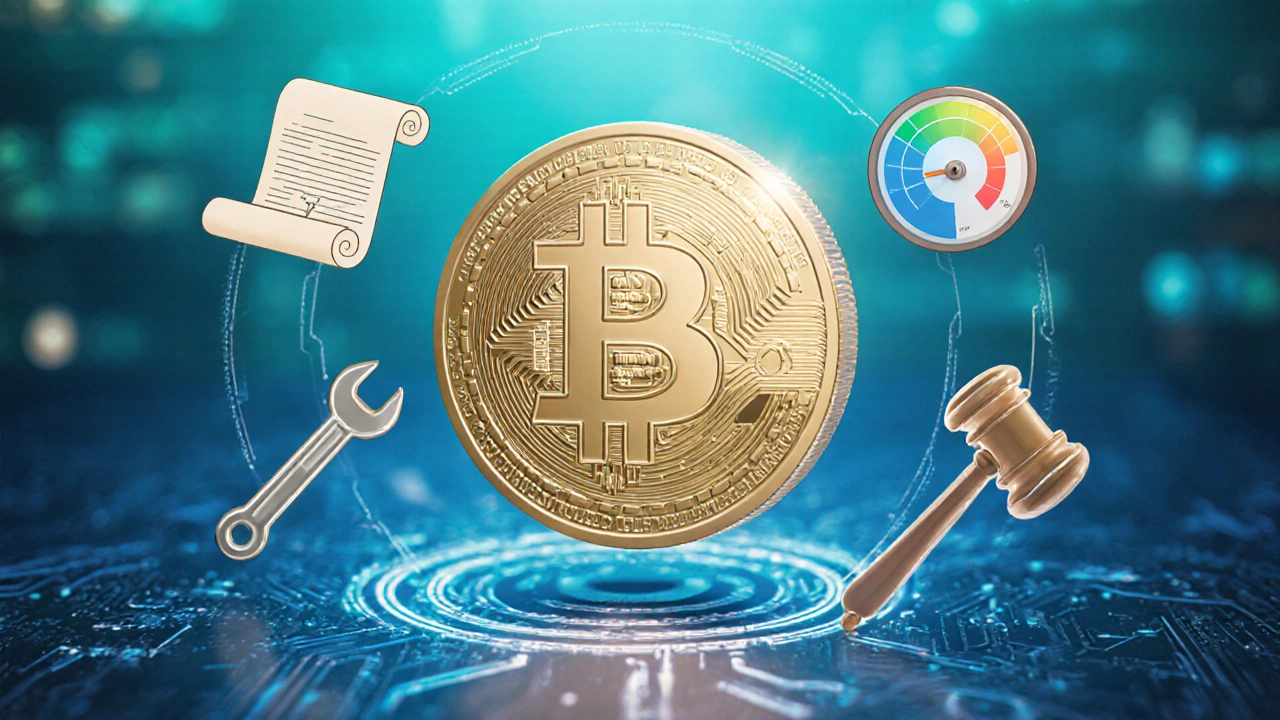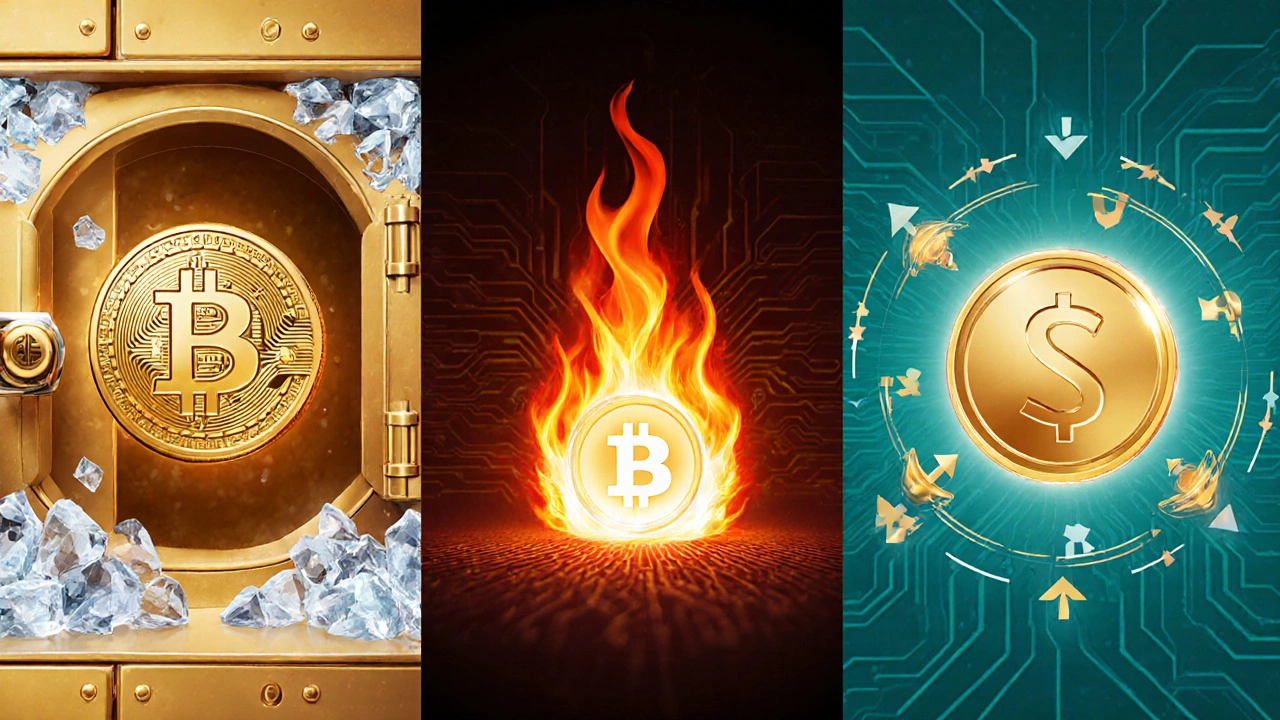
Understanding why a coin’s price jumps or drops isn’t magic - it’s largely about tokenomics. When you look past hype and focus on the underlying economic design, you can see what really pushes a cryptocurrency up or down.
Key Takeaways
- Token supply mechanisms (fixed, inflationary, deflationary) set the price ceiling.
- Utility and governance features create demand beyond speculation.
- Burns, staking rewards, and liquidity incentives directly affect circulating supply.
- Market sentiment amplifies or dampens the impact of tokenomic changes.
- A simple checklist helps you evaluate any token’s price potential.
What is Tokenomics?
Tokenomics is a blend of "token" and "economics" that describes the monetary policy, distribution model, and incentive structure behind a cryptocurrency. It answers questions like: How many tokens will ever exist? How are new tokens created? What rights do holders have? By answering these, tokenomics sets the stage for price movements.
Core Tokenomic Factors That Move Prices
Four pillars dominate the price equation: supply, demand, utility, and governance.
1. Token Supply Models
Fixed supply tokens (e.g., Bitcoin’s 21million limit) create scarcity. Inflationary supply adds new units each block, which can dilute value unless offset by demand. Deflationary mechanisms-like token burns-remove coins from circulation, increasing scarcity over time.
2. Demand Drivers
Demand isn’t just speculation. Real‑world use cases-payments, gaming, decentralized finance (DeFi)-create baseline buying pressure. The more a token is needed to access a service, the higher its intrinsic demand.
3. Utility Tokens vs. Governance Tokens
A utility token grants access to a platform’s features (e.g., gas fees on Ethereum). A governance token lets holders vote on protocol upgrades. Both generate demand, but governance tokens add a political‑risk premium-price can swing with community sentiment.
4. Token Burn & Staking
Token burn permanently destroys a portion of the supply, often announced as a quarterly event. This visibly reduces circulating supply and can trigger short‑term price spikes.
Staking rewards lock tokens in a contract and pay interest in the same asset. While staking reduces circulating supply, the promised rewards add an inflation component. Balancing the two is crucial for long‑term price stability.

Real‑World Examples
Seeing tokenomics in action helps cement the concepts.
- Bitcoin (BTC): Fixed supply of 21million creates strong scarcity. Halving events cut new supply in half, historically preceding bull runs.
- Ethereum (ETH): Transition to ETH2.0 introduced a burn mechanism (EIP‑1559). Combined with a modest inflation rate, the net effect has been a decreasing effective supply, supporting price appreciation.
- Binance Coin (BNB): Quarterly burns funded by Binance’s profits have reduced supply by over 20% since launch, directly boosting price.
- Solana (SOL): Inflationary supply of ~8% per year is offset by high demand for transaction throughput and staking incentives, keeping price relatively stable despite a larger token pool.
Comparison Table: Token Types and Typical Price Impact
| Token Type | Primary Economic Hook | Typical Price Driver | Risk Factor |
|---|---|---|---|
| Fixed‑Supply (e.g., BTC) | Scarcity | Halving / Market Liquidity | Demand shock sensitivity |
| Inflationary (e.g., SOL) | Staking rewards | Reward yield vs. new issuance | Oversupply risk |
| Deflationary / Burn (e.g., BNB) | Supply reduction | Burn announcements | Burn schedule uncertainty |
| Utility (e.g., MATIC) | Network usage | Transaction volume growth | Adoption lag |
| Governance (e.g., COMP) | Voting power | Protocol proposals | Community fragmentation |
Quick Checklist: Evaluating Tokenomics Before Buying
- Identify the total and circulating supply. Is it fixed, inflationary, or deflationary?
- Look for burn schedules or buy‑back programs. How much supply is planned to be removed?
- Assess utility: What real actions require the token? Higher usage means stronger demand.
- Check staking or reward mechanisms. Calculate net inflation after rewards are factored in.
- Review governance rights. Active voting can create price spikes around proposals.
- Gauge market sentiment: Are recent announcements bullish or bearish?
- Consider liquidity: Is the token listed on major exchanges? Poor liquidity can amplify price swings.

Common Pitfalls When Interpreting Tokenomics
Even seasoned traders miss a few traps.
- Ignoring vesting schedules. Large token allocations for founders or investors can flood the market once cliffs expire.
- Over‑valuing short‑term burns. One‑off burns boost price temporarily but don’t guarantee long‑term scarcity.
- Assuming high staking yields equal higher price. Staking can lock supply, but the inflation built into rewards may offset the scarcity benefit.
- Neglecting regulatory risk. Tokens with governance functions may attract tighter scrutiny, affecting price.
Frequently Asked Questions
How does a token burn affect price?
A burn permanently removes tokens from the circulating supply, creating scarcity. If demand stays constant, the reduced supply pushes the price upward. The effect is strongest when the burn size is a noticeable percentage of total supply.
Can inflationary tokenomics still yield high prices?
Yes, if the token’s utility drives strong demand that outpaces the rate of new issuance. Staking rewards can also lock a large portion of supply, effectively reducing circulating tokens despite inflation.
What role does market sentiment play?
Sentiment amplifies tokenomic fundamentals. Positive news (e.g., upcoming burn) can cause a price surge, while negative community votes can yank the price down even if supply metrics look solid.
Should I prioritize utility over governance?
Utility offers a steady base demand because users need the token to interact with the platform. Governance adds a speculative layer-price can swing with political events-but also gives holders a voice. A balanced token usually mixes both.
How often should I revisit a token’s economics?
At least quarterly. Look for new burns, changes in staking APR, supply updates, and major protocol proposals. Tokenomics evolve, and price predictions get stale quickly.
Next Steps
Armed with the checklist, start by picking a coin you’re curious about. Pull its token supply data from the blockchain explorer, read the latest whitepaper section on economics, and map each factor to the list above. If the numbers line up-scarce supply, high utility, reasonable inflation-you’ve got a solid price‑potential case.
Remember, tokenomics are a tool, not a crystal ball. Combine them with broader market analysis, stay updated on protocol news, and keep emotions in check. That’s the real edge in the crypto arena.
